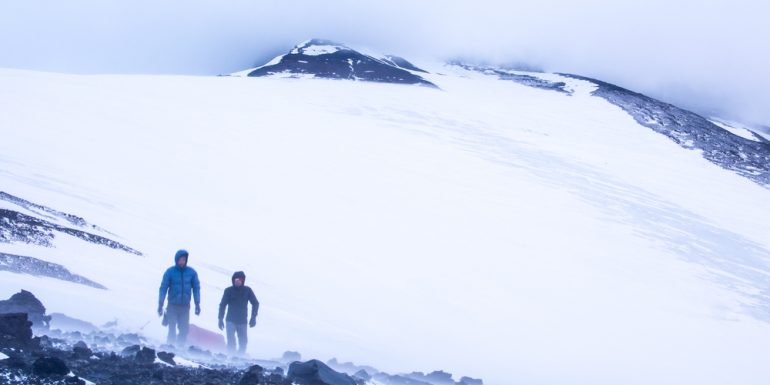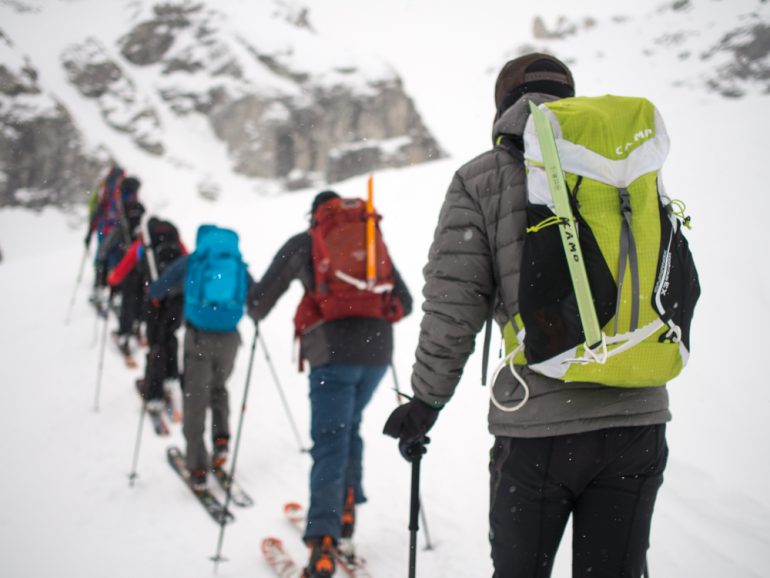
Work side by side with your mentor. Understand your respective roles, but count on everyone “pulling their weight”. Jed Porter and Dave Riggs at 5000m in Chile. October 2017. Photo: Jed Porter.
Jed is a longtime guide bringing humility and a desire to help others reach their potential in the mountains to his craft. Several years ago, he penned a two-part series on mentorship for WildSnow. This is the first piece in the series, “Going on your first ski tour? Seek good company,” is the second. The series first ran in 2019.
These pieces get us thinking about the season ahead and who we can learn from. The pieces offer sound advice for potential mentees and mentors alike.
Tips for making the most of the coveted mentorship
Photos by Jed Porter
You need a mentor. I need a mentor. We each need lots of them. And we each get to be mentors. How do you find one? What should you expect from a mentorship interaction and what shouldn’t, you ask? How do you prepare to “take the next step” in the company of someone more experienced than myself?
Mentorship is a buzzword. Yet, it is absolutely critical. Whether you glaze over at the cliched mention of such an idea or not, you will likely participate in some sort of mentorship. You might just refer to the relationship differently. “This gal/guy just took me on my first 6000 foot touring day. I had no idea something like that was possible!” Or, “It sure is nice to ride with someone who is so stoked and receptive to wisdom. She/he’s gonna break all the trail next time!”. Regardless of how you frame it, stepping up requires stepping into a mentorship relationship.
Four years ago, I offered to WildSnow readers my own mentorship council. In that process I met many great people and forged lasting relationships. One such individual, a guy named Kevin, and I recently climbed the Ham and Eggs route on Alaska’s Moose’s Tooth. We did some skiing too. In any case, these recent years I’ve reflected further on mentorship. I have some tips, thoughts, and ideas for those seeking it.
Find a mentor
First, securing a mentor can be a daunting task. As with any low-ratio social interactions, first-hand introductions are most valuable. Put it out there that you are looking for mentored guidance. Bring something to the table, put yourself in position to meet people (backcountry skiing classes, group trips, festivals, slide shows, and popular touring zones), and realize the limitations of mentorship.
Understand the limitations
Let me expand more on the “limitations of mentorship.” A protege will do really well to align his or her expectations. Great mentorship is both more than you can ever imagine, and less than you think you might want. Your best “use” of a mentor is in application of skills. Learn component skills on your own time, and really tap into a mentor’s guidance in learning when and how to employ said skills. The real gold that someone more experienced can impart is in the more nebulous aspects of backcountry travel. Your mentor could certainly teach you to put skins on and to arrange a rappel and to perform snow grain analysis. However, those things are even better learned in an instructional environment, with mentor time spent learning the nuances of when and why to execute or not execute said tasks.
Before you find a mentor
In order to get the most out of mentor/mentee relationship, it’s important to have a foundation of “basics” in the backcountry. At every level of backcountry skiing and ski mountaineering you need to understand gear selection, rescue skills, uphill techniques, gear use, fitness improvement, snow science, skiing wild snow and route-finding/navigation. There is a basic level of understanding of each of these required for your very first outing. And you need to learn more advanced versions of each basic skill for each incremental step up and out. Do your learning of these things outside of your mentor relationship. Read the books, watch the videos, take the classes, hire the guides and do the trial and error for acquisition of the hard skills. With generous resort uphill policies around the world, and the plethora of free online tutorials, you can learn the basic component skills of backcountry skiing well before setting foot in the backcountry. Do that. Come to your mentor with an understanding of how to perform the fundamentals.

Guided group trips and classes are a great way to meet new partners and pick up more of the basic skills. Here, the Haute Route.
What to expect from a mentor
Taking time to learn the basics will position you to better absorb from your mentor the application of these fundamentals. Your mentor, whether he or she knows it or not, will show you how to find good snow and how to pace yourself. You’ll learn with a mentor when to kick turn and when to do something else. You’ll learn from your mentor when to stay at home. You’ll learn from your mentor when a seated hip belay is preferable to a direct anchor belay. Your mentor will likely wax poetic on the real-world application of that extended saw test. You’ll pick up tips and tricks, and advance your skills with a mentor, but make that the secondary goal. No single part of backcountry skiing is all that complicated. As one mentor of mine has said, “it isn’t rocket surgery.” However, putting it all together is the art. Mentorship enables you to learn that art in a supportive environment.
That support also takes the form of actual support. A mentor is a back stop to your skills in new environments. You learned how to break trail from that free video, but you grossly underestimated the physical demands. Your mentor can smooth the day out and renew the psyche. You miss the v-thread three times in a row. Your mentor nails it the next time, before the sun peeks around the corner onto those overhead mushrooms. You followed the manufacturer’s instructions for adjusting the bindings, but they still come off all the time. Your mentor has seen this before, and knows what to do. You brought two left gloves, and your spacey mentor brought two right gloves. Serendipity. And a note of caution in that final comical anecdote: your mentor isn’t perfect. But he or she can provide a real margin for error.
Consider what you can offer a mentor
But… what am I bringing to the table? Why would someone so much more experienced than me want to take her or his time with me? Well, that one’s easy; partners are damn hard to find. Even the most well-connected skiers come hard up against the “I have no partner for xyz mission”. If you come in with the component skills dialed (and I mean dialed, for the situation. Dial in the gear, the fitness, the skiing, the knowledge) for the mission at hand, and everyone wins. Any excellent potential ski mentor will gladly take on just a little more responsibility in the judgement department in exchange for an eager and honed partner.
I’d even make a case that there is a benefit to clearly defined roles in a ski partnership or group. We love democracy. It underpins our entire culture. However, it gets onerous in the backcountry. Some of the best experiences are those in which each party clearly understands her “place”. Each person then works to transcend her role, doing more than the others could possibly expect. But the “chain of command” and judgement hierarchy is clear. This isn’t a popular or trendy view on wilderness decision making. Giving everyone a voice and everyone a veto is crucial. But the buck stops somewhere. Clearly defined, whether implicitly or explicitly, roles take any debate from the hierarchy.
Hopefully this brief screed better aligns some expectations on mentorship, and prompts further discussion and thought. There is much about the situation that remains unsaid. As you read this, we’re working on more similar conversations, building on this topic. Most notably, how do you know someone is a good ski mentor? Or, even more basically, how do you know someone is a good partner choice for your first backcountry experiences? In my next post I expand on exactly this, giving a short checklist that anyone can use to vet your ski partners.
Jed Porter is a passionate adventure skier and all-around mountain professional. His primary work is as a mountain guide, skiing and climbing all over the Americas and beyond. Learn more about him at his website linked below.
